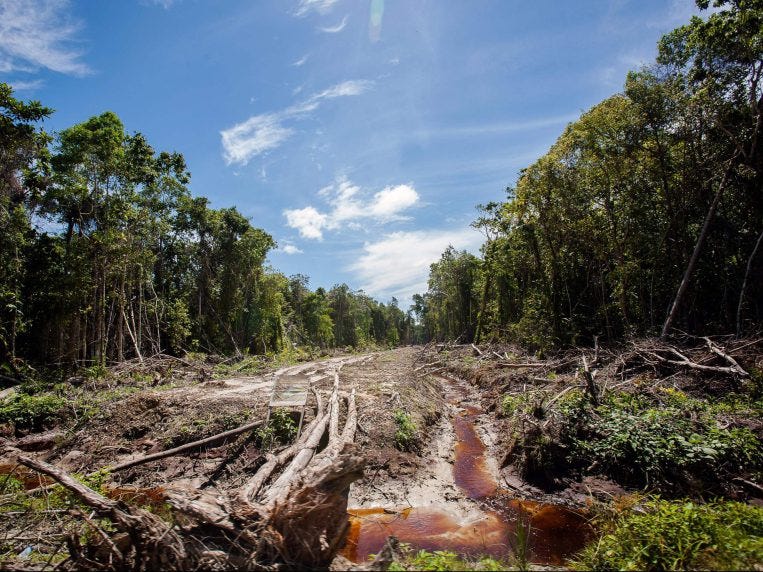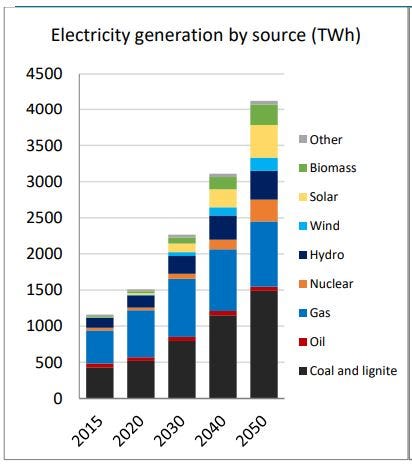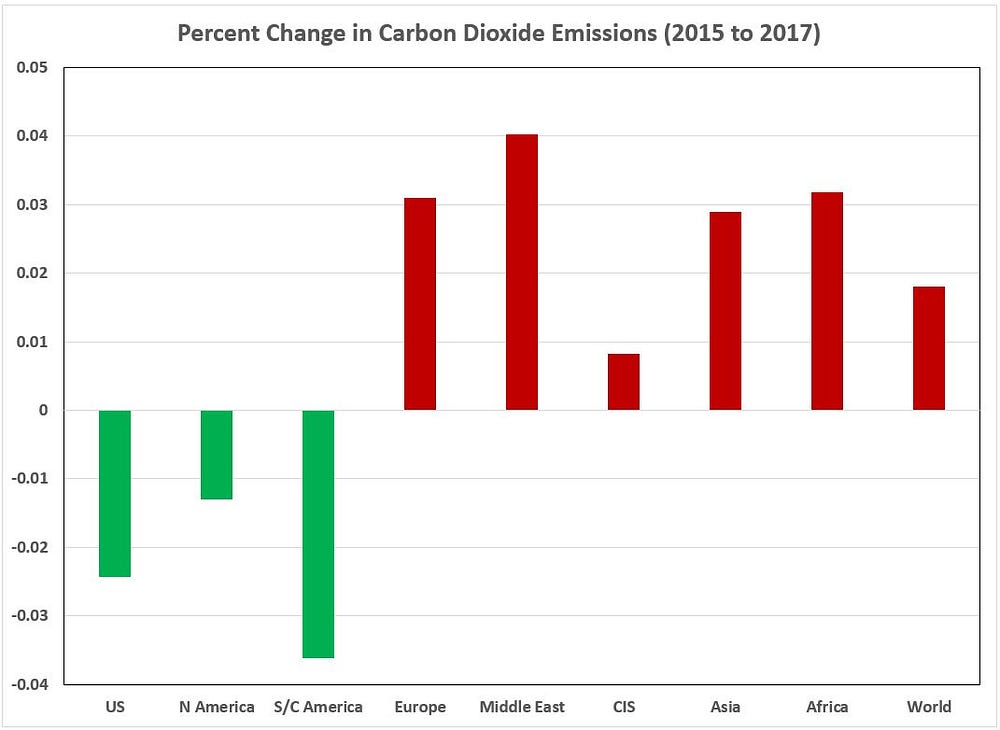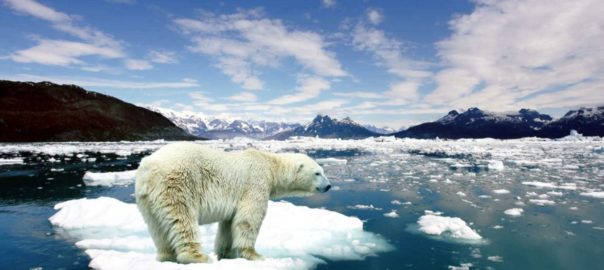By Kent R. Kroeger (October 12, 2018; Source: NuQum.com)
Current global warming is real, it is man-made, and its consequences will be profoundly negative over time. The significant loss of polar ice, damage to the coral reefs, increased flooding along coastlines and other waterways, more frequent heatwaves, and an increased risk of forest fires are among the most likely consequences as the earth continues to warm.
Theory and empirical data support these predictions, unequivocally.
That reality, however, is being cynically weaponized by an unqualified chattering class that seeks partisan advantage, even at the risk of war.
Reactions to the latest Intergovernmental Panel on Climate Change (IPCC) report on climate change exemplify this problem…
“The impact of human-induced warming is worse than previously feared, the IPCC report released Monday says, and only drastic coordinated action will keep the damage short of catastrophe,” warns Washington Post columnist Eugene Robinson.
“Food shortages and wildfires will get worse, coral reefs will die off and sea levels will rise by feet rather than inches in our lifetimes if too little is done,” writes The Chicago Sun-Times Editorial Board. “It’s the epic battle of our age. Every nation, every major corporation — all of us — must work to win it.”
Replace the term ‘human-induced warming’ with ‘terrorism’ or ‘weapons of mass destruction’ and its the kind of rhetoric you hear right before the bombs start dropping. The president’s national security advisers would already have a prioritized list of ‘rogue’ countries to attack and would be feeding the national media the necessary propaganda to build public support for such attacks.
But Robinson and The Sun-Times are talking about climate change, and their latest hair-on-fire rant on a topic where their knowledge is superficial is just another futile attempt to shock the American people into believing the human race is facing an existential crisis like no other in history. Soon the environmental lobby will be using Shriners Hospital kids to make their pleas.
The urgency of climate change is hard to sell to the American people — and for good reason. Though a majority of Americans believe in global warming is human-induced, most are still not willing to make a major financial sacrifice to address the problem. Politicians would have an easier time selling the additional tax burden of ‘Medicare-for-All’ than a carbon tax or ‘tax and ‘trade’ system to accelerate the phase-out of fossil fuels.
According to the IPCC’s own economic analysis, for every year through 2050, it will cost the world between $1.6 trillion and $3.8 trillion in “energy system supply-side investments” to possibly keep future global warming below 1.5 degrees Celsius. That could end up costing the world $122 trillion by 2050…or as little as $51 trillion.
The IPCC harms the global warming cause when they float cost analysis nonsense like: $122 trillion by 2050. Economists are already calling the IPCC cost estimate preposterous. Yet, the climate change lobby thinks those mammoth cost numbers will spur people into action on the problem. In fact, the exact opposite is true.
Basic human psychology leads people to tune out such large, abstract numbers. It becomes Monopoly money.
If people are to fund a multi-trillion dollar, global effort to combat climate change, they will need specific estimates about how it will impact their household finances. And they’ll want to know how the money will be used and who will be making the decisions about where it goes. Some will ask, ‘Why are Midwest taxpayers forced to subsidize those who choose to build homes along coastlines in hurricane zones or in dry, heavily forested areas of California?’ And imagine the fraud and abuse that will inevitably occur should the governments around the world get an extra $122 trillion to squander.
Given the options, it is hard to blame someone if they decide to take their chances with global warming.
Let us assume the IPCC cost estimate is accurate. No democratically-elected government would survive raising taxes as much as $49 per gallon gas tax by 2030. Ergo, no government will raise taxes anywhere close to that number, which means the Paris Climate Accord goal to keep anomalous global warming below 1.5 degrees Celsius is as good as dead. To limit the warming to 2 degrees Celsius, however, the IPCC estimates a $1.70 per gallon gas tax by 2030 is necessary — that number at least has a puncher’s chance of earning voter approval.
Putting the cost estimates aside, the latest IPCC report is trying to convince us that climate change poses an existential threat to the human race and its negative impact is happening now, is happening faster than expected, and will only get worse. In the IPCC’s view, doing nothing (or ‘muddling through’) is not an option (Truth: Muddling through is always an option). That is why the Paris Climate Accord was so important to the activist community. The primary accomplishment of the Accord, over even the specific country-level goals, was to get every country in the world to sign on to the notion that everyone must do their part. The Paris Climate Accord was good politics and wrongfully dismissed by climate change skeptics.
However, experience tells us that some countries will pursue a zero-carbon economy more vigorously than others. And some countries will be outright freeloaders, continuing to rely on fossil fuels for domestic energy production or as a major export commodity. Try to convince Russia that open Arctic sea lanes in the summer represent a global “crisis” or U.S. Midwest farmers that longer growing seasons are a threat to humanity.
They will never buy what the climate change activists are selling.
But, should the climate change lobby gain access to a new tax revenue stream, they WILL find ways to expand the tax. Give lobbyists the chance and they will pump money out of your paycheck faster than Aramco pumps crude out of the Saudi desert.
Besides, once a government convinces its people about the necessity of a surtax or some other new revenue stream, the lobbyists make sure the problem never goes away.
The Free-rider Problem
In the near-term, there are large segments of the world population that benefit from global warming (for example, people spend more on entertainment when the weather is warmer).
That reality escapes most climate change activists, but if they expect the average citizen to give up a significant portion of their incomes to solve the global warming problem, they will need to understand Who wins? and Who loses? in the battle against climate change.
When the IPCC throws out financial numbers in the tens of trillions of dollars, there will be industries and countries that stand to gain (or lose) a lot of money from combating climate change. It will be one of history’s largest transfers of wealth — most likely, from the advanced industrialized economies (e.g., U.S., Europe, Japan, etc.) to the developing world. So, don’t act surprised if the Kremlin draws a clear line in the sand over the limits of what Russia is willing to sacrifice over climate change. And don’t be surprised if that means using their military power to protect their interests.
And all of this begs the questions: Is it possible the human race could spend tens of trillions of dollars to fight global warming and still not appreciably slow it down? Or might we engage in a geoengineering project to slow global warming — such as creating more clouds — and end up doing more damage to the planet?
Despite the Paris Climate Accord, not all countries are going jump on board this climate change bandwagon with the same levels of fellowship and cooperation as the Germans or French.
If Malawi or Trinidad and Tobago decide not to participate in the worldwide decarbonization effort, it won’t have a major impact. But if the country is Indonesia, currently the third largest emitter of greenhouse gases after the U.S. and China, the likelihood of meeting the Paris Accord goals are jeopardized.
Despite being a signatory to the Paris Climate Accord, Indonesia continues to develop peatland forest areas, releasing carbon dioxide into the atmosphere, and remains the world’s second largest exporter of coal and lignite, behind only Australia.

Domestic energy generation remains very carbon intensive in Indonesia and other Southeast Asia countries (see Figure 1). According to the energy consulting firm Enerdata: “The share of coal in the region’s power mix will remain stable through 2050 at current levels: approximately 35% of total generation. Wind and solar combined will account for 15% of the total power generation in 2050, from almost 0% today. Meanwhile, gas-fired generation will drop from about 40% in 2017 to 22% in 2050.”
Figure 1: Energy Generation by Source in Southeast Asia

As long as coal is cheap and available in Southeast Asia, it will be widely used to address the region’s growing electricity needs.
Unfortunately, that poses a problem for meeting the IPCC’s 2030 deadline for decreasing net human-caused emissions by about 45 percent from 2010 levels. Though Southeast Asia accounts for only 3.4 percent of the world economy and about 9 percent of the world’s population (~650 million people), the region emits about 40 percent as much carbon dioxide (CO2) as the European Union.
U.S. and European efforts alone are not enough to address global warming. That should be obvious.
Climate change is a collective action problem and the U.S. and Europe are dependent on other countries to do their part — countries that in some cases are already hostile to Western interests in general.
Are the U.S. and Europe going to carry the burden on implementing climate change solutions and passively let Indonesia or Brazil or India or any other large greenhouse gas emitter shirk their obligations?
Probably not.
But what exactly can the U.S. and Europe do to ensure climate policy compliance across the globe?
In the past, the U.S. has used its military to protect vital interests
Some analysts argue the U.S. military has already engaged in its first climate change-influenced conflict: The Syrian Civil War. The argument goes like this: Global warming exacerbated an extreme drought experienced within Syria prior to its civil war; which led to large-scale internal migration; and this migration contributed to the the socio-economic stresses that were the proximal cause of the Syrian Civil War.
As compelling as the argument may be to climate change activists, the empirical data supporting such a view of the Syrian Civil War does not hold up to scrutiny, according to a group of American, British and German researchers.
Regardless, the U.S. Department of Defense (DoD) at present sees climate change as a “threat multiplier” because it has the potential to exacerbate many of the challenges we are dealing with today — from infectious disease to terrorism.” In the DoD’s opinion, climate change will instigate resource shortages for human necessities such as water and other basic foodstuffs that will, in turn, increase social instability and the likelihood of ‘resource’ wars.
In its 2014 Climate Change Adaptation Roadmap, DoD planners see climate change most likely impacting U.S. humanitarian and peacekeeping requirements abroad, as well as threatening military training facilities at home and overseas through more intense natural disasters. Specifically, DoD considers rising sea levels, flooding, droughts, wildfires, and more extreme temperatures as the primary threats to U.S. military personnel and readiness posed by climate change.
“We must also work with other nations to share tools for assessing and managing climate change impacts, and help build their capacity to respond,” writes then-Secretary of Defense Chuck Hagel in the 2014 Roadmap. “Climate change is a global problem. Its impacts do not respect national borders. No nation can deal with it alone. We must work together, building joint capabilities to deal with these emerging threats.”
Since the publication of the 2014 Roadmap, its most tangible results have been: (1) transitioning as much of DoD’s energy needs as possible to renewable sources, and (2) adapting U.S. military installations worldwide to the most likely weather-related threats associated with climate change.
The problem with climate change, however, is that the U.S. is dependent on other countries to also reduce carbon emissions on a worldwide scale. If only the advanced economies significantly reduce emissions, while other large developing countries such as India, China and Indonesia continue to burn fossil fuels, the U.S. and European efforts will be for naught. For the world to keep global warming from exceeding 1.5 or 2 degrees Celsius, every large economy must cooperate. Failing on this requirement will have dire consequences on all nations, according to the IPCC.
But what exactly can the U.S. do to impel Indonesia, for example, to abandon its coal industry or for India to stop building new coal plants?
The last three years offer a vivid example of this problem. According to British Petroleum’s data on carbon dioxide (CO2) emissions worldwide between 2015 and 2017, the world’s CO2 emissions have gone up 1.8 percent (!) since the signing of the Paris Climate Accord (see Figure 2). And you can’t blame the U.S. for this increase, as its CO2 emissions have decreased 2.4 percent in the same period.
Figure 2: Change in Carbon Dioxide (CO2) Emissions since 2015

Why have U.S. CO2 emissions decreased, while in other regions of the world they have increased? Two reasons: (1) increases in renewable energy power generation and (2) an increase in the exploitation (including fracking) of natural gas reserves account for the U.S. success story.
Contrary to what is often reported in the U.S. mainstream media, the U.S. is aggressively converting to renewable energy and is on the path to a 100-percent renewable energy economy by 2055 — only five years beyond the Paris Climate Accord goals (see Figure 3 below). The U.S. is not the problem.
Figure 3: U.S. Renewable Energy Forecast for Renewables, Nuclear and Hydroelectric (Share of Total Electricity Generation)

Failure to meet the IPCC’s 2030 goals will not be because of U.S. inaction on global warming. More likely, the failure will originate from the fastest growing regions of the world — Asia and Africa.
And how should (or will) the U.S. respond to these climate change laggards?
Apart from doing nothing (an always attractive option), there are four policy options at the U.S.’s disposal when dealing with countries that are falling behind the Paris Climate Accord and IPPC goals:
(1) Engage in diplomacy that incentivizes countries to change their policies,
(2) Implement economic boycotts and trade restrictions to coerce policy change,
(3) Use covert operations to engineer coups against the leaders of climate change laggards, or
(4) simply attack or invade the laggard countries and force their conversion to renewable energy.
It may sound laughable to think the U.S. and its allies would consider military attacks, coups or invasions to force climate change policy changes, but that is exactly what the advanced industrialized countries have been doing for the past 60 years in the Middle East to protect Western energy interests.
Why should renewable energy and climate change be any different? If U.S. national security is at risk due to climate change, as reflected in official DoD policy and inferred in the most recent IPCC report, why wouldn’t military force and covert intelligence operations be included on the policy options menu?
If the IPCC is correct, failing to address climate change is an existential threat to the U.S. and all nations. In such a circumstance, it would be irresponsible for the U.S. not to consider military options with respect to climate change. If humankind is at stake, why not bomb some coal plants in Indonesia and India?
Even senior U.S. military officers are regurgitating the urgency of the IPCC position on climate change.
“Planning for the long-term implications of climate change today is as important as planning for a major Pacific conflict was in the last century,” according to U.S. Navy Commander Timothy McGeehan. “To address climate change, the Department of Defense (DoD) and Pacific Command (PaCom) in particular need a 21st-century War Plan Orange.”
War Plan Orange was a secret strategy the U.S. military had been developing since 1906 in case a war with Japan ever broke out. As we know, on December 7, 1941, a war with Japan did materialize and War Plan Orange formed the blueprint for our nation’s successful defeat of Japan.
If you believe climate change is as big a threat to U.S. strategic interests as the Japanese were in 1941, why wouldn’t you consider of using U.S. military superiority to enforce the goals set forth by the IPCC?
That argument is not as far-fetched as it sounds.
It doesn’t take much for the neoliberal and neoconservative hawks in the U.S. to justify a regime change war. Offer them the premise that war will save the planet from the ravages of global warming and you have a formula for concocting all sorts of excuses to attack Venezuela or Indonesia or Iran or Russia…and the list goes on…
With this newest IPCC report, we already see the machinations of the political and media elite preparing the American people to fight the good fight against climate change — and, yes, don’t argue with them when the federal and state governments take more and more of your income to solve a problem that’s already being solved. They will do it because they have the moral high ground and know what is best.
We are watching you Indonesia, China, Brazil, Russia, and the Democratic Republic of the Congo. If you are not doing your part to fight climate change, our Marines are more than happy to set you straight.
That the current climate change hysteria could lead to a hot war is not inconceivable. Is there anything about today’s Democratic Party and Never Trump Republicans that suggests they would rule out using overwhelming military superiority to promote their dearest cause?
The U.S. and international media consistently misrepresent the climate change threat, a man-made menace that is real but manageable, because accepting this doomsday premise further empowers the Davos elites who have been talking about this potential power grab for well over a decade.
Imagine what they could do with an additional $122 trillion dollars of everyone’s money. The climate change alarmists have every incentive to exaggerate its dangers and the cost of its mitigation.
Luckily, history is still on the side of climate change realists. When former Vice President Al Gore warned us in 2006 that we had only a decade left to save the planet from global warming, he was deliriously uninformed. In his words, 2016 was the point of no return.
It is 2018. The Earth is doing just fine. Humans on this Earth have never been more prosperous or safer. Perhaps Al Gore’s apocalyptic prediction has been delayed? Maybe we should still be worried that he is right?
No, Al is not right. He’s never been right on this issue. He (and the Democrats, in general) have taken a real problem — the warming of the planet due to human activity — and exploited it for political and personal gain.
They are exploiters, not leaders.
Al Gore and the climate change panic mavens need to spend more time in the science labs at MIT where they are leading the research on carbon capture and sequestration. Or how about going to China where their research and development of solar farms is on the brink of transforming how humans capture energy?
The climate change scaremongering exhibited by the mainstream media over this latest IPCC report has one unspoken goal: It is a raw power grab by political statists (mostly in the U.S. and Europe) trying to control as much of your money as they can possibly get their grubby hands on.
Don’t be fooled. Climate change is just another problem humans will ultimately solve. It is what humans do best. We solve problems — and make money in the process.
The world is moving as fast as can be expected in converting to a 100-percent renewable energy economy (see the evidence here). It will never be fast enough for environmental doomsayers, but it is fast enough to save this planet from the worst consequences of global warming. And a mix of incremental policy-making and targeted crisis spending will help the world’s nations adapt to the likely consequences of climate change. The incremental adaptive approach is not sexy and will not be as pro-active as the climate change lobby would like, but it is how the human race will address climate change.
Climate change will lead to wars fought over resources (water, arable land) and migration. And, as suggested in this essay, the climate change vanguard may even try to impose their will on some climate change free-rider nations who refuse to take orders from the West.
In the meantime here in the U.S., beware of climate change hysteria being exploited by neoliberals and neocon military hawks as a way to justify their lust for expanding the role of government or finding new ways to get the U.S. military involved in more regime change wars.
Climate change activists are the modern crusaders and they will do anything to save the planet — including spending your money to do it.
Consider yourself warned.
- K.R.K.
